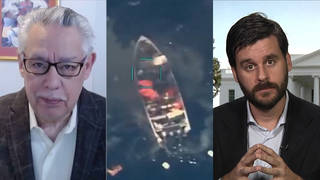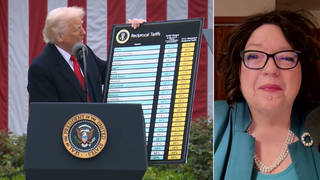
Topics
Guests
- Michael Risherstaff attorney at the ACLU of Northern California. One of his clients is challenging California’s law that allowed her to have her DNA tested when she was arrested at a protest. Her charges were later dropped, but her DNA remains in a federal database.
- Mia Fernandezexecutive director of the National Center for Victims of Crime, which runs a DNA Resource Center that advises lawmakers and law enforcement officials about the use of DNA in the criminal justice system.
In a landmark decision, the U.S. Supreme Court has ruled the police can collect DNA samples from people they arrest even before they are convicted of a crime. Supporters of the swabbing method call it “the fingerprinting of the 21st century” that will help nab criminals and break open unsolved cases. But privacy advocates say the ruling is vague because it does not define what constitutes a “serious crime,” and could create an incentive for police to make more arrests. The Supreme Court’s 5-to-4 ruling will likely fuel an expansion of DNA swabbing nationwide. We host a debate between Michael Risher of the American Civil Liberties Union and Mai Fernandez of the National Center for Victims of Crime.
Transcript
NERMEEN SHAIKH: We turn now to a major decision by a divided U.S. Supreme Court that allows police to take DNA samples when a person is arrested for a, quote, “serious” crime. The case centered on a Maryland law used to take a DNA test of a man arrested for a felony assault. The test matched DNA in a rape case six years earlier that had previously gone unsolved. This is an exchange from the case’s oral arguments, between Maryland’s Chief Deputy Attorney General Katherine Winfree and Justice Antonin Scalia, who later wrote in his dissent that the law violates the Fourth Amendment’s protection against unreasonable search and seizure.
KATHERINE WINFREE: Mr. Chief Justice, and may it please the court, since 2009, when Maryland began to collect DNA samples from arrestees charged with violent crimes and burglary, there have been 225 matches, 75 prosecutions and 42 convictions, including that of respondent King.
JUSTICE ANTONIN SCALIA: Well, that’s really good. I’ll bet you if you conducted a lot of unreasonable searches and seizures, you’d get more convictions, too. That proves absolutely nothing.
KATHERINE WINFREE: Well, I think, Justice Scalia, it does in fact point out the fact that the statute is working. And in the state’s view, the act is constitutional.
NERMEEN SHAIKH: Ultimately, the court upheld Maryland’s law, which lets police use a swab to collect DNA from the cells inside a person’s cheek. Supporters of the method call it, quote, “the fingerprinting of the 21st century.” So far, 25 states have passed laws that are similar to Maryland’s. Some even allow DNA swabs for misdemeanor arrests. But privacy advocates say the ruling is vague because it does not define what constitutes a “serious crime” and could create an incentive for police to make more arrests.
AMY GOODMAN: Well, with this five-to-four ruling, more states are likely to adapt similar measures despite such concerns.
And for more, we’re joined by two guests. In San Francisco, Michael Risher is with us, staff attorney with the ACLU of Northern California. His views were summed up in a post headlined “Supreme Court Ruling a Blow to Genetic Privacy.” One of his clients is challenging California’s law that allowed her to have her DNA tested when she was arrested at a protest against the Iraq War. Her charges were later dropped, but her DNA remains in a federal database.
We’re also joined in Washington, D.C., by Mai Fernandez, executive director of the National Center for Victims of Crime, which runs a DNA Resource Center that advises lawmakers and law enforcement officials about the use of DNA in the criminal justice system.
We welcome you both to Democracy Now! We’re going to Washington first to Mai Fernandez. You support this decision. Tell us why.
MAI FERNANDEZ: We do support the decision. And the reason for it is that so many lives are going to be saved. If we can know ahead of time, before somebody is going to commit a grievous act, who a person is through their DNA, by their DNA being in the system, and the arrest allows us to have that in the system, we can, A, find cold cases that haven’t been solved, and, B, prevent other heinous crimes from happening, like murder and rape. So, we do support the decision. We also support that it be—that when other states take this up, and the states that currently doing DNA on arrest, that they do it in an ethical way that provides the best evidence that we can get and the most definitive evidence that we can get.
NERMEEN SHAIKH: I want to play an excerpt from the oral arguments in the case, Maryland v. King. This is Maryland’s Chief Deputy Attorney General Katherine Winfree being questioned by Justice Elena Kagan, who later sided with the dissent.
KATHERINE WINFREE: The cornerstone of our argument is that when an individual is taken into custody, an individual is arrested on a probable cause, on a probable cause arrest, that person, by virtue of being in that class of individuals whose conduct has led police to arrest him on—based on probable cause, surrenders a substantial amount of liberty—
JUSTICE ELENA KAGAN: But, Ms. Winfree, that can’t be quite right, can it? I mean, such a person—assume you’ve been arrested for something. The state doesn’t have the right to go search your house for evidence of unrelated crimes. Isn’t—isn’t that correct?
KATHERINE WINFREE: That’s correct, Justice Kagan.
JUSTICE ELENA KAGAN: Doesn’t have the right to go search your car for evidence of unrelated crimes.
KATHERINE WINFREE: That’s correct.
JUSTICE ELENA KAGAN: Just because you’ve been arrested doesn’t mean that you lose the privacy expectations and things you have that aren’t related to the offense that you’ve been arrested for.
KATHERINE WINFREE: That’s correct. But what we’re seizing here is not evidence of crime. What it is is information related to that person’s DNA profile, those 26 numbers—
JUSTICE ELENA KAGAN: Well, and if there were a real identification purpose for this, then I understand that argument. But if it’s just to solve cold cases, which is the way you started, then it’s just like searching your house to see what’s in your house that could help to solve a cold case.
KATHERINE WINFREE: Well, I would say there’s a very real distinction between the police generally rummaging in your home to look for evidence that might relate to your personal papers and your thoughts, a very real difference there than swabbing the inside of an arrestee’s cheek to determine what that person’s CODIS DNA profile is. It’s looking only at 26 numbers that tell us nothing more about that individual.
JUSTICE ELENA KAGAN: Well, but if that’s what you’re basing it on, then you’re not basing it on an arrestee. I mean, then—the chief justice is right—it could be any arrestee, no matter how minor the offense. It could be just any old person in the street. Why don’t we do this for everybody who comes in for a driver’s license, because it’s very effective?
KATHERINE WINFREE: I think the difference there is, these people are lawfully in custody, having been arrested based on probable cause.
NERMEEN SHAIKH: I want to bring in Michael Risher of the American Civil Liberties Union. Michael Risher, could you respond to the oral arguments being made in this case?
MICHAEL RISHER: Well, Justice Kagan is exactly right. This is a general rummaging through our genetic blueprint to look for evidence of unknown, completely unrelated crimes, with no reason to think that the person who’s been arrested for maybe a minor offense has committed any other crime. It’s an incredible broadening of the government’s authority to stick its fingers into our bodies, seize our bodily tissue, seize the DNA profile, and put it in an enormous criminal database, with no suspicion to think that that’s going to uncover any crime.
NERMEEN SHAIKH: What about claims, Michael Risher, that DNA testing or taking DNA swabs is the equivalent of fingerprinting, the 21st century equivalent? Could you respond to that?
MICHAEL RISHER: That’s completely wrong. Our fingerprints tell us nothing about ourselves. Our DNA is our genetic blueprint. The government here is not just seizing 26 numbers; it’s seizing our entire genome, analyzing part of it, keeping the rest of it so that it can analyze the rest of it in the future, if the need arises or if the laws change to allow it to conduct more intrusive searches. And the government is already using these DNA profiles in ways that we could never imagine fingerprints being used for. Maryland doesn’t, but many states engage in what’s called “familial searching,” where they look through their DNA database, they don’t find a matching sample, but they find 100, 150 that are close enough. They think maybe one of them belongs to the perpetrator’s family members, blood family members, and so they then go investigate those people. Calling this a fingerprint is really a rhetorical device to try to hide the incredible invasion of privacy that occasions when somebody, a police officer, sticks something in your mouth, swabs around for 30 seconds, and seizes your genetic blueprint.
AMY GOODMAN: Mai Fernandez, your response?
MAI FERNANDEZ: Well, the last time I had my fingerprints taken, my hand was grabbed. I was—it was put in a bunch of ink, and it was rolled over a piece of paper. So, one could say that sticking a Q-tip in your mouth and rubbing it around may be intrusive, but I really do think that it’s not particularly intrusive. All they’re doing is swabbing a little bit of the saliva from the inside of your mouth and putting it on a stick. It’s not hugely intrusive.
And I’ve got to say that fingerprinting has been around for over a hundred years. DNA has only been a tool that we’ve had since 1985. It is a new tool that is letting us investigate and identifying the right person. That’s the incredible thing. That’s why DNA is the gold standard for identification. We’re not getting the wrong person. We’re getting the right person when we have a DNA swab. So, one could say it’s very intrusive. I don’t think it’s that intrusive. And in addition, what we’re doing is saying, this really is a perfect match. We don’t get that kind of match with fingerprints. We don’t get that kind of match with a picture that’s taken at a mugshot at arrest. We finally have a tool that can say, yes, this is the person that we’re looking for.
And so, part of—part of the challenge here is figuring out how we do this with the right kinds of protocols to making sure that we’ve got the right kind of testing being done in the right set of circumstances. We’ve had a hundred years to deal with fingerprinting on how to use them. Now it’s time to really learn how to use DNA properly. The Supreme Court said we can. Now we’ve got to come up with the right protocols to be able to do that in a fair and ethical way. We’re not out to do things that just go in and create lots of privacy problems for individuals. We’re out there trying to solve crimes, trying to stop people getting murdered and raped, and in those situations where we haven’t been able to know who the perpetrator is, to be able to find them. This is the tool of the 21st century that we need to learn how—
AMY GOODMAN: So, Michael Risher, what is wrong with what Mai Fernandez is saying and what the Supreme Court ruled, that this is about accuracy?
MICHAEL RISHER: Well, I agree 100 percent DNA has revolutionized our criminal justice system. It’s freed the innocent. It’s helped catch the guilty. It’s not perfect, because people are involved in it. And there’s a very recent, horrible example out here of some horrible mistake gone wrong that’s put someone, an innocent man, in jail facing capital charges because of DNA. But, in general, DNA is great.
What’s bad for our criminal justice system, what’s bad for our privacy and what’s bad for our constitutional rights is taking DNA from people who are presumed innocent, simply because a single police officer may suspect them of committing some inconsequential crime, and putting their DNA in a giant criminal database. We should be spending our resources, our lab resources, our money, taking DNA from people who are convicted of crimes—not people presumed innocent, convicted of crimes—and testing all of the thousands of untested sex assault kits, other rape kits and other crime scene DNA evidence, so that we can connect those convicted criminals to actual crime scenes. We should not be wasting our money invading people’s privacy, taking DNA from people who will never be charged with a crime, who will certainly never be convicted of a crime—people like my client Lily Haskell, who just got arrested at a peace rally, other of my clients who got arrested at political demonstrations. They haven’t committed any sort of crime. They certainly haven’t committed any crimes where DNA is going to be relevant. But their genetic blueprints are now sitting in a giant criminal database. That’s simply not right.
NERMEEN SHAIKH: Michael Risher, I want to turn to a clip from your client. This is lead plaintiff Lily Haskell speaking on CNN.
LILY HASKELL: I was arrested at an antiwar demonstration in 2009. And when I was arrested, I was really surprised. I did not know about the law, even though I had voted against it, but I didn’t know it went into effect. And so, they took me out of the cell, and they said, you know, “We’re here to collect your DNA.” And I was shocked. I said I would not like to have my DNA taken. I believed that I had the right to refuse to have my DNA taken. And when I refused, they said, “OK, well, if you refuse, you’ll be charged with another misdemeanor, which will land you two more nights in jail.” And at that point I was—you know, I was a little bit nervous. I was confused about what was going on. I didn’t want to spend two more nights in jail. I felt strong-armed, like I had to give my DNA.
NERMEEN SHAIKH: Michael Risher, that was Lily Haskell, your client. Could you comment on this case?
MICHAEL RISHER: Well, our case is a class action challenging the taking of DNA from people in California who simply have been arrested for what can be a very minor crime, something like simple drug possession, joyriding, or Lily arrested at a peace rally when she allegedly tried to help one of her fellow demonstrators who had been arrested. She was never charged with a crime. None of or few of our clients were ever charged with any sort of crime. Nonetheless, their DNA was taken. There was no warrant. There was no reason to take their DNA, just this very intrusive law that says you have to do it, and if you refuse, the police can take it by force, or you can be charged with a misdemeanor and spend six months in jail.
And so, we challenged this because the reality is, cases where people are arrested and there is DNA evidence at the scene—for example, in a serious crime, a rape, where there’s DNA evidence at the scene—the police can do what they always have done. They can use the same probable cause that justified the arrest to get a warrant to seize that person’s DNA, and then they can analyze that and connect that person to the crime or any other crime. What the police should not be doing is taking DNA from people who are presumed innocent, with no judicial involvement, simply because a single police officer has made this decision to arrest somebody at a peace rally in what might have been a mass arrest.
AMY GOODMAN: Mai Fernandez, we have 30 seconds. Your last response, especially on this issue of the lead plaintiff, Lily Haskell?
MAI FERNANDEZ: Well, I think we have to look at what the Supreme Court ruled on. They ruled on serious crime, taking DNA upon arrest on serious crime. In the Maryland case, it was second-degree assault that he was arrested on. And the DNA was taken at that time. And what they got was a hit on a cold case of a rape. So, we’re looking at a tool, the tool of the 21st century, to be able to identify. If you keep it at serious crime, taking DNA—what the Supreme Court ruled on, serious crime, taking DNA on arrest, and being able to find out who raped that poor woman? I think that it justifies that—the swab being taken and the DNA taken at arrest. I think that if you look—we can look at the protest crimes. We can look at taking DNA at arrest for minor crimes. But that’s not what the Supreme Court has ruled on. Right now we’re looking at serious crime that’s solving major cases. So, I think that the Supreme Court did the right thing. And going forward, we’re going to be saving lives and solving crimes.
AMY GOODMAN: Well, we’ll continue to follow this issue and how it plays out. I want to thank you both for being with us, Michael Risher, staff attorney, ACLU of Northern California, and Mai Fernandez, executive director of National Center for Victims of Crime.
When we come back, we look at a new book, Crow After Roe: How “Separate But Equal” Has Become the New Standard in Women’s Health. Stay with us.












Media Options